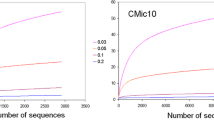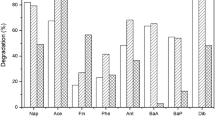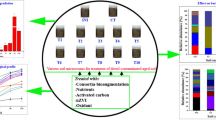Abstract
Hydrocarbons are ubiquitous and persistent organic pollutants in the environment. In wetlands and marine environments, particularly in mangrove ecosystems, their increase and significant accumulation result from human activities such as oil and gas exploration and exploitation operations. Remediation of these ecosystems requires the development of adequate and effective strategies. Natural attenuation, biostimulation, and bioaugmentation are all biological soil treatment techniques that can be adapted to mangroves. Our experiments were performed on samples of fresh mangrove sediments from the Cameroon estuary and mainly from the Wouri River in Cameroon. This study aims to assess the degradation potential of a bacterial consortium isolated from mangrove sediment. The principle of our bioremediation experiments is based on a series of tests designed to evaluate the potential of an active indigenous microflora and three exogenous pure strains, to degrade diesel with/without adding nutrients. The experiments were conducted in laboratory flasks and a greenhouse in microcosms. In one case, as in the other, the endogenous microflora showed that it was able to degrade diesel. Under stress of the pollutant, the endogenous microflora fits well enough in the middle to enable metabolism of the pollutant. However, the Rhodococcus strain was more effective over time. The degradation rate was 77 and 90 % in the vials containing the sterile sediments and non-sterile sediments, respectively. The results are comparable with those obtained in the microcosms in a greenhouse where only the endogenous microflora were used. The results of this study show that mangrove sediment contains an active microflora that can metabolize diesel. Indigenous and active microflora show an interesting potential for diesel degradation.












Similar content being viewed by others
References
Abioye, O. P., Agamuthu, P., & Abdul-Aziz, R. A. (2012). Biodegradation of used motor oil using organic waste amendment. Biotechnology Research International. doi:10.1155/2012/587041Research.
Adams, G. O., Fufeyin, P. T., Okoro, S. E., Ehinomen, I. (2015). Bioremediation, Biostimulation and Bioaugmention: A Review. International Journal of Environmental Bioremediation & Biodegradation, 3(1), 28–39.
Alongi, D. M. (1988). Bacterial productivity and microbial biomass in tropical mangrove sediments. Microbiology Ecology, 15, 59–79.
Atagana, H. I. (2008). Compost bioremediation of hydrocarbon-contaminated soil inoculated with organic manure. African Journal of Biotechnology, 7(10), 1516–1525.
Atlas, R. M., & Bragg, J. (2009). Bioremediation of marine oil spills: when and when not—the Exxon Valdez experience. Microbial Biotechnology, 2(2), 213–221.
Atlas, R. M. (1981). Microbial-degradation of petroleum-hydrocarbons—an environmental perspective. Microbiological Reviews, 45(1), 180–209.
Barathi, S., & Vasudevan, N. (2001). Utilization of petroleum hydrocarbons by Pseudomonas fluorescens isolated from a petroleum-contaminated soil. Environmental International, 26(5-6), 413–416.
Bartha, R., & Bossert, I. (1984). The treatment and disposal of petroleum wastes. In Petroleum Microbiology (Ed.), R. M. Atlas (pp. 553–578). Macmillan: New York, USA.
Bento, F. M., Camargo, F. A. O., Okeke, B. C., Frankenberger, W. T. (2005). Comparative bioremediation of soils contaminated with diesel oil by natural attenuation, biostimulation and bioaugmentation. Bioresource Technology, 96, 1049–1055.
Bernard, D., Pascaline, H., Jeremie, J. J. (1996). Distribution and origin of hydrocarbons in sediments from lagoons with fringing mangrove communities. Marine Pollution Bulletin, 32, 734–739.
Bicca, F. C., Fleck, L. C., & Ayub, M. A. Z. (1999). Production of biosurfactant by hydrocarbon degrading Rhodococcus ruber and Rhodococcus erythropolis. Revista de Microbiologia, 30, 231–236.
Bragg, J. R., Prince, R. C., Harner, E. J., & Atlas, R. M. (1994). Effectiveness of bioremediation for the Exxon Valdez oil spill. Nature, 368, 413–418.
Brandao, P. F., Clapp, J. P., & Bull, A. T. (2003). Diversity of nitrile hydratase and amidase enzyme genes in Rhodococcus erythropolis recovered from geographically distinct habitats. Applied and Environmental Microbiology, 69, 5754–5766.
Brito, E. M. S., Guyoneaud, R., Goñi-Urriza, M., Ranchou-Peyruse, A., Verbaere, A., Crapez, M. A. C., Wasserman, J. C. A., & Duran, R. (2006). Characterization of hydrocarbonoclastic bacterial communities from mangrove sediments in Guanabara Bay, Brazil. Research in Microbiology, 157, 752–762.
Brooijmans, R. J. W., Pastink, M. I., & Siezen, R. J. (2009). Hydrocarbon-degrading bacteria: the oil-spill clean-up crew. Microbial Biotechnology, 2(6), 587–594.
Bulman, T. L., & Newland, M. (1993). In situ bioventing of a diesel fuel spill. Hydrological Sciences Journal, 8, 297–308.
Chandrasekhar, N., & Karigar, C. S. (2010). Bacterial degradation of anthracene by pseudomonas fluorescens KCP2. Asian Journal of Microbiology, Biotechnology & Environmental Sciences, 12(3), 591–597.
Chaneau, C. H., Morel, J., Dupont, J., Bury, E., & Oudot, J. (1999). Comparison of the fuel oil biodegradation potential of hydrocarbon-assimilating microorganisms isolated from a temperate agricultural soil. Science of the Total Environment, 227, 237–247.
Chen, J., Wong, M. H., Wong, Y. S., & Tam, N. F. Y. (2008). Multi-factors on biodegradation kinetics of polycyclic aromatic hydrocarbons (PAHs) by Sphingomonas sp. a bacterial strain isolated from mangrove sediment. Marine Pollution Bulletin, 57, 695–702.
Chikere, C. B. (2012). Culture-independent analysis of bacterial community composition during bioremediation of crude oil-polluted soil. British Microbiology Research Journal, 2(3), 187–211.
Christova, N., Tulevaa, B., & Nikolova-Damyanova, B. (2004). Enhanced hydrocarbon biodegradation by a newly isolated Bacillus subtilis strain. Zeitschrift für Naturforschung, 59c, 205–208.
Colwell, R. R., Walker, J. D., & Cooney, J. J. (1977). Ecological aspects of microbial degradation of petroleum in the marine environment. Critical Reviews in Microbiology, 5(4), 423–445.
Cooney, J. J., Silver, S. A., & Beck, E. A. (1985). Factors influencing hydrocarbon degradation in three freshwater lakes. Microbial Ecology, 11(2), 127–137.
Darsa, K. V., Thatheyus, A. J., & Ramya, D. (2014). Biodegradation of petroleum compound using the bacterium Bacillus subtilis. Science International, 2(1), 20–25.
Das, K., & Mukherjee, A. K. (2007). Crude petroleum-oil biodegradation efficiency of Bacillus subtilis and Pseudomonas aeruginosa strains isolated from a petroleum-oil contaminated soil from North-East India. Bioresource Technology, 98(7), 1339–1345.
Ellis, R. J., Morgan, P., Weightman, A. J., & Fry, J. C. (2003). Cultivation-dependant and independent approaches for determining bacterial diversity in heavy metal contaminated soil. Applied and Environmental Microbiology, 69, 3223–3230.
Fan, M. Y., Xie, R. J., & Qin, G. (2013). Bioremediation of petroleum-contaminated soil by a combined system of biostimulation-bioaugmentation with yeast. Environmental Technology, 35, 4.
Floodgate, G. (1984). The fate of petroleum in marine ecosystems. In P. Microbiology (Ed.), R. M. Atlas (pp. 355–398). Macmillan: New York, USA.
Fulekar, M. H. (2010). Global status of environmental pollution and its remediation. In Fulekar M. H. (Eds.), Recent Advances. Bioremediation Technology, 1–6.
Ghaly A. E., Yusran A., Dave D. (2013). Effects of biostimulation and bioaugmentation on the degradation of pyrene in soil. Journal Bioremediation Biodegradation, 5, 1–13.
Hamamura, N., Fukui, M., Ward, D. M., & Inskeep, W. P. (2008). Assessing soil microbial populations responding to crude-oil amendment at different temperatures using phylogenetic, functional gene (alkB) and physiological analyses. Environmental Science and Technology, 42, 7580–7586.
Holguin, G., Vazquez, P., & Bashan, Y. (2001). The role of sediment microorganisms in the productivity, conservation, and rehabilitation of mangrove ecosystems: an overview. Biology and Fertility of Soils, 33, 265–278.
Jalilzadeh Yengejeh, R., Sekhavatjou, M. S., Maktabi, P., Arbab Soleimani, N., Khadivi, S., & Pourjafarian, V. (2014). The biodegradation of crude oil by Bacillus subtilis isolated from contaminated soil in hot weather areas. International Journal of Environmental Research, 8(2), 509–514.
Kaczorek, E., & Olszanowski, A. (2011). Uptake of hydrocarbon by Pseudomonas fluorescens (P1) and Pseudomonas putida (K1) strains in the presence of surfactants: a cell surface modification. Water, Air, and Soil Pollution, 214, 451–459.
Karpenko, E. V., Vil’danova-Martsishin, R. I., Shcheglova, N. S., Pirog, T. P., & Voloshina, I. N. (2006). The prospects of using bacteria of the genus Rhodococcus and microbial surfactants for the degradation of oil pollutants. Applied Biochemistry and Microbiology, 42, 156–159.
Khan, M., & Scullion, J. (2002). Effects of metal (Cd, Cu, Ni, Pb or Zn) enrichment of sewage-sludge on soil micro-organisms and their activities. Applied Soil Ecology, 20, 145–155.
Larkin, M. J., Kulakov, L. A., & Allen, C. C. R. (2005). Biodegradation and Rhodococcus—masters of catabolic versatility. Environmental Biotechnology, 16, 282–290.
Leahy, J. G., & Colwell, R. R. (1990). Microbial degradation of hydrocarbons in the environment. Microbiological Reviews, 5, 305–315.
LePetit, J., & N'Guyen, M.-H. (1976). Besoins en phosphore des bacteries metabolisant les hydrocarbures en mer. Canadian Journal of Microbiology, 22, 1364–1373.
Lu, H., Zhang, Y., Liu, B., Liu, J., Ye, J., & Yan, C. (2011). Rhizodegradation gradients of phenanthrene and pyrene in sediment of mangrove (Kandelia candel (L.) Druce). Journal of Hazardous Materials, 196, 263–269.
Liu, C. W., & Liu, H. S. (2011). Rhodococcus erythropolis strain NTU-1 efficiently degrades and traps diesel and crude oil in batch and fed-batch bioreactors. Process Biochemistry, 46, 202–209.
Mehdi, F. S., Siddiqu, I. A., Ali, N. I., & Afzal, M. (2000). Rhizosphere mycoflora of black mangrove seedling at Karachi coast. Pakistan Journal of Biological Sciences, 3(8), 1352–1353.
Moran, A. C., Olivera, N., Commendatore, M., Esteves, J. L., & Sineriz, F. (2000). Enhancement of hydrocarbon waste biodegradation by addition of a biosurfactant from Bacillus subtilis O9. Biodegradation, 11, 65–71.
Moreira, I. T. A., Oliveira, O. M. C., Triguis, J. A., Dos Santos, A. M. P., Queiroz, A. F. S., Martins, C. M. S., Silva, C. S., & Jesus, R. S. (2011). Phytoremediation using Rhizophora mangle L. in mangrove sediments contaminated by persistent total petroleum hydrocarbons (TPH’s). Microchemical Journal, 29, 376–382.
Orji, F. A., Abiye, A. I., & Dike, E. N. (2012). Laboratory scale bioremediation of petroleum hydrocarbon—polluted mangrove swamps in the Niger Delta using cow dung. Malaysian Journal of Microbiology, 8(4), 219–228.
Owens, E. H., Solsberg, L. B., West, M. R., & McGrath, M. (1998). Field guide for oil spill response in arctic waters (Emergency prevention, preparedness and response (EPPR), p. 348). Yellowknife, NT Canada: Environment Canada.
Perry, J. J. (1984). Microbial metabolism of cyclic alkanes. In Petroleum Microbiology (Ed.), R. M. Atlas (pp. 61–98). New York, USA: Macmillan.
Queiroga, C. L., Nascimento, L. R., & Serra, G. E. (2003). Evaluation of paraffin biodegradation and biosurfactant production by Bacillus subtilis in the presence of crude oil. Brazilian Journal of Microbiology, 34(4), 321–324.
Rahman, K. S. M., Rahman, T. J., Kourkoutas, Y., Petsas, I., Marchant, R., & Banat, I. M. (2003). Enhanced bioremediation of n-alkane in petroleum sludge using bacterial consortium amended with rhamnolipid and micronutrients. Bioprocess Technology, 90(2), 159–168.
Ramsay, M. A., Swannell, R. P. J., Shipton, W. A., Duke, N. C., Hill, R. T. (2000). Effect of bioremediation on the microbial community in oiled mangrove sediments. Marine Pollution Bulletin, 41(12), 413–419.
Singh, A., Kumar, V., & Shrivastava, J. N. (2010). Green biotechnology of EM in bioremediation of wastewater. Geobios, 37, 231–237.
Steffensen, W. S., & Alexander, M. (1995). Role of competition for inorganic nutrients in the biodegradation of mixtures of substrates. Applied and Environmental Microbiology, 61, 2859–2862.
Tam, N. F. Y., & Wong, Y. S. (2008). Effectiveness of bacterial inoculum and mangrove plants on remediation of sediment contaminated with polycyclic aromatic hydrocarbons. Marine Pollution Bulletin, 57, 716–726.
Tam, N. F. Y., Guo, C. L., Yau, W. Y., & Wong, Y. S. (2002). Preliminary study on biodegradation of phenanthrene by bacteria isolated from mangrove sediments in Hong Kong. Marine Pollution Bulletin, 42, 316–324.
Tian, Y., Liu, H. J., Zheng, T. L., Kwon, K. K., Kim, S. J., Yan, C. L. (2008). PAHs contamination and bacterial communities in mangrove surface sediments of the Jiulong River Estuary, China. Marine Pollution Bulletin, 57, 707–715.
Ulrici, W. (2000). Contaminant soil areas, different countries and contaminant monitoring of contaminants. In: H.J. Rehm and G. Reed (Eds.), Environmental Process II. Soil Decontamination Biotechnology, 11, 5-42.
Venosa, A.D., Lee, K., Suidan, M.T., Garcia-Blanco, S., Cobanli, S., Moteleb, M., Haines, J.R., Tremblay, G., & Hazelwood, M. (2002). Bioremediation and biorestoration of a crude oil contaminated freshwater wetland on the St. Lawrence River. Bioremediation Journal, 6(3), 261–281.
Wang, Q., Zhang, S., Li, Y., & Klassen, W. (2011). Potential approaches to improving biodegradation of hydrocarbons for bioremediation of crude oil pollution. Journal of Environmental Protection, 2, 47–55.
Wenderoth, D. F., Rosenbrock, P., Abraham, W. R., Pieper, D. H., & Höfle, M. G. (2003). Bacterial community dynamics during biostimulation and bioaugmentation experiments aiming at chlorobenzene degradation in groundwater. Microbial Ecology, 46, 161–176.
Wild, S. R., & Jones, K. C. (1986). Biological and abiotic losses of polynuclear hydrocarbons from soils freshly amended with sewage sludge. Environmental Toxicology and Chemistry, 12, 5–12.
Wu, T., Xie, W. J., Yi, L., Li, X. B., Yang, B. H., & Wang, J. (2012). Surface activity of salt-tolerant Serratia spp. and crude oil biodegradation in saline soil. Plant, Soil and Environment, 58(9), 412–416.
Yakimov, M. M., Timmis, K. N., & Golyshin, P. N. (2007). Obligate oil-degrading marine bacteria. Current Opinion in Biotechnology, 18(3), 257–266.
Yu, S. H., Ke, L., Wong, Y. S., & Tam, N. F. Y. (2005). Degradation of polycyclic aromatic hydrocarbons (PAHS) by a bacterial consortium enriched from mangrove sediments. Environment International, 31, 149–154.
Zhang, X., Kimmel, M. R. D., McGilliard, C., & Boicourt, W. (2006). Spatial variability in plankton biomass and hydrographic variables along an axial transect in Chesapeake Bay. Journal of Geophysical Research, Oceans, 111(5), 1978–2012.
Zhang, C. G., Leung, K. K., Wong, Y. S., & Tam, N. F. Y. (2007). Germination, growth and physiological responses of mangrove plant (Bruguiera gymnorrhiza) to lubricating oil pollution. Environmental and Experimental Botany, 60, 127–136.
Author information
Authors and Affiliations
Corresponding author
Rights and permissions
About this article
Cite this article
Lang, F.S., Destain, J., Delvigne, F. et al. Characterization and Evaluation of the Potential of a Diesel-Degrading Bacterial Consortium Isolated from Fresh Mangrove Sediment. Water Air Soil Pollut 227, 58 (2016). https://doi.org/10.1007/s11270-016-2749-7
Received:
Accepted:
Published:
DOI: https://doi.org/10.1007/s11270-016-2749-7




